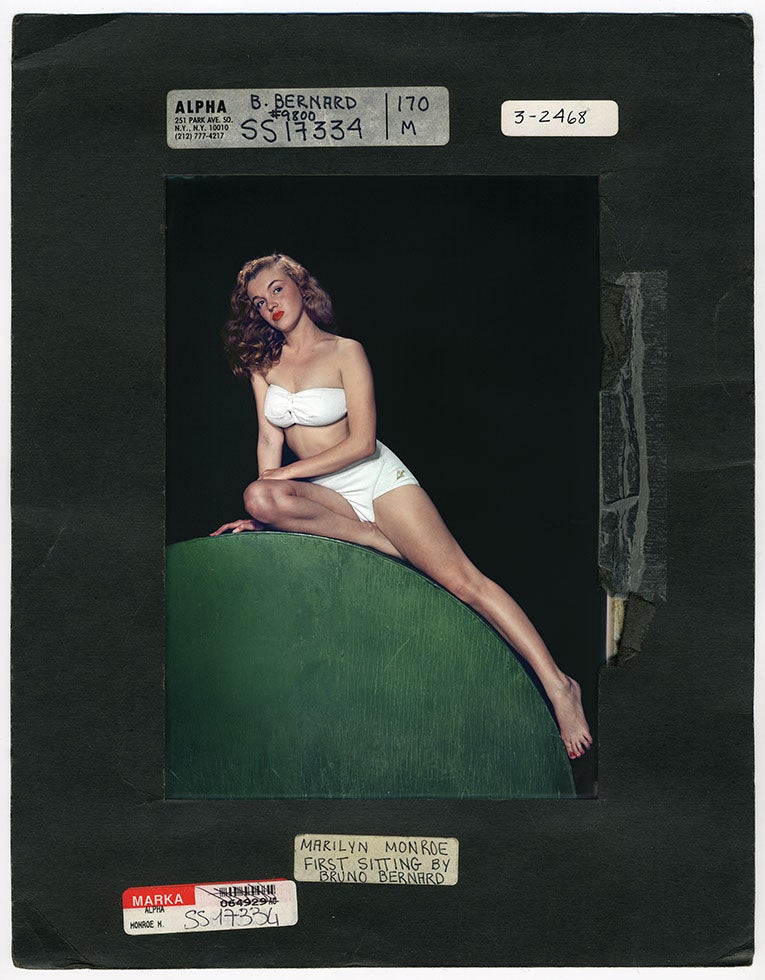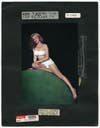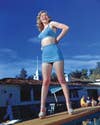Unseen Marilyn
The following is adapted from Marilyn: Intimate Exposures by Susan Bernard, photos by Bruno Bernard In New York City, Marilyn...


The following is adapted from Marilyn: Intimate Exposures by Susan Bernard, photos by Bruno Bernard
In New York City, Marilyn walks out of the Trans-Lux theatre onto the movie set. She steps directly over the subway grate, four steps to the left, and comes down hard on her feet, with the stance of a lion, legs splayed, feet in high-heeled white sandals. Her skirt is in the air, a soft, billowing sheet, revealing fleshy thighs and white cotton panties.
An exasperated director, one Billy Wilder, holds up his megaphone, shouts “Roll it!” for the 16th time. She throws her blonde head back, closing her eyes in exhilaration, enjoying the warm breeze. She whispers, “Ahhh, what a relief! Isn’t it delicious?”
In the crowd, camera bulbs burst like shattering glass. An iconic moment of the 20th century is minted, with a photograph that further amplifies Marilyn’s mythology.

The One
My father was not the only photographer to capture the moment, but 50 years later, when New York’s Museum of Modern Art chose its most significant symbol of the century (for its Fame After Photography exhibition in 1999), it was his picture that appeared 60 feet high on the exterior of the museum. Why?
My father’s friendship with Marilyn outlasted all of her relationships with other men. He knew the real Marilyn, not the created one. Their enduring bond stretched back to 1946, when a young woman named Norma Jean passed him as he emerged from a dentist’s office. What follows is excerpted from his journals from that period. —Susan Bernard
The Indian summer temperature had made the thermometer climb up over 90 degrees. After more than two hours under the laser light of my dentist, I groggily left the office with a swollen cheek and slowly made my way back to my studio a few blocks away. While I was making up my mind whether to cancel my next appointment, a dazzling teenager with a voluptuous figure wiggled by. She had curves in all the right places and she moved with the unadulterated sensuality of Lili St. Cyr and Tempest Storm when they were stripping on the stage of the Burbank Theater on Main Street. I found my arm waving and my mouth whistling the lovely vision to a halt. A rather rude method, I must admit.
Not knowing what to say, I offered my card and said, “Miss, this is strictly professional. I’d like to take some photo tests of you.”
At six o’clock the next morning, Norma Jean’s black Ford jalopy screeched to a halt outside the Bernard of Hollywood Studio at 9055 Sunset Boulevard. —SB
Before I finished putting my unwieldy 5×7 Eastman camera on its tripod, Norma Jean emerged from her large beach towel, ready for action.
I started giving her directions. “Would you please climb up on the front girder so I can get a better angle on your leg?”
“Oh, you want to make a Varga girl out of me,” Norma Jean commented knowingly. “All legs and a shrunken head. I know what you’re up to, Mr. Bernard!”
“What’s wrong with the Varga girls?” I wanted to know.
“Not a thing. I wish I could look like his Ziegfeld beauties in Esquire—they’re divine—but no real girl could ever look like those drawings, could she?”

The First Time
“Not quite, but photographers can create a similar illusion by elongating the legs from a low perspective, but not so low as to distort the proportions of the head too much.” Her enthusiasm and tenacity were infectious. After hours of continuous shooting, she was still fresh.
“I want to become a movie star!” she declared, swirling her hips. “It’s been my dream since I was a kid. You’ve got to help me, Bernie.” And she quickly took out my publicity brochure and repeated every word. “Professional photography has as its prime purpose selling an actor or a professional performer to producers, directors and, of course, the public.”
“You’ve got to take a few more sexy photos of me,” she insisted, making boring obscene gestures. “That will be my open sesame to the studios.”
“Norma, darling, whatever you do, never put hot on hot—that looks vulgar and would turn a real man off. Let your curves tell it all, and counteract the body language with a complete look of innocence. Your eyes should be asking, ‘Why do men look at me?’ Blend waif with Venus and you’ll create combustion in photos.”
After sessions, she started to confide in me. Especially after she heard that I, too, was brought up in an orphanage because of the pitiful way we lived when we were with my family.
“I never really lived with my mother. I had… let’s say 10 or 11 foster families. My mother was put in a crazy house in Norwalk. You ever been to Norwalk, Mr. Bernard? I was told she had paranoid schizophrenia. My grandmother and grandfather died in one of those crazy places. I don’t know when she went away, but I have dreams of her pushing me in a baby carriage and I’m wearing a pretty white dress.
“After a while in the orphanage I’d pretend she was dead. I cleaned toilets and worked in the kitchen washing dishes. There were a hundred of us. We made five cents a month. At night when everyone was sleeping, I’d sit up in the window and cry. I’d look over in the distance, and there was this tall water tower, and on the top of it, it said ‘RKO.’ My mother had worked as a cutter at RKO. I can’t even see her face. She was a woman with red hair.”
“And your father, Norma Jean?”
“On weekends, sometimes the foster families would sit me in a movie theater from morning ’til night.” In the corner of her eye a tear appeared. “I’d watch Clark Gable and pretend he was my father…” Norma Jean told me there was a portrait of a smiling Gable tacked to her wall.
This real-life Cinderella story transported me back to the newspaper and scrap-metal route of my childhood in Berlin. It released my empathy for this girl born on the wrong side of the tracks who seemed hell-bent on making the American Dream come true for herself. She became my “little sis” and I promised to help her all I could. “The world is your oyster, Norma Jean. I was alone and penniless when I kissed the ground on Ellis Island. We are survivors, you and I.”
From the initial sitting I was able to place an advertisement with a pharmaceutical manufacturer depicting Norma Jean bandaging Rolf’s “injured paw.” The dog definitely stole the show, a fact that did not escape Norma Jean’s critical judgment when she looked at the proof sheets. After she became Marilyn Monroe she saw to it that nobody stole a scene from her again.
In 1949, after being dropped by two studios, my father took her on a modeling assignment at the private Palm Springs Racquet club—a destination for disappearance. —SB
“Who’s this gorgeous dame—your girlfriend?” I knew at that instant this could only have been Johnny Hyde. Short in stature, but long in connections. I felt annoyed at what he was implying.

“Trust you don’t mind me taking a few snaps, strictly for private use!” Without waiting for an answer to his rhetorical questions, Johnny made a quick dash to his bungalow adjacent to the pool and stormed out armed with a Leica and several telephoto lenses. To the amusement of all bystanders, the former circus acrobat turned agent crouched on his belly and fired away from his frog perspective as if Eastman Kodak would go out of business tomorrow. After he had shot his bolt of 36 exposures he ran back to his bungalow for more ammunition.
This interlude prompted Marilyn to ask, “Who is this jerk snapping all of these pictures?”
“This jerk is Johnny Hyde, an ardent amateur photographer. Professionally he happens to be vice president of the William Morris Agency,” I whispered in her ear. After this input, I might just as well have packed my camera gear.
Johnny was Marilyn’s Professor Higgins. He revamped her completely from the loveable, carefree All-American Girl to the breathtakingly beautiful but dumb Hollywood blonde, a type that could be sold much more easily to the studios and the masses. A cosmetic surgeon in the Springs restyled her nose and straightened the facial tissues under her skin. The changeover from the natural nice girl next door to the siren Marilyn was complete. Johnny negotiated a seven-year contract with Fox for her.

Her childhood dreams coming true, days later, Johnny succumbed to a heart attack. —SB
Upon seeing the marquee advertising for As Young As You Feel, she was in such high spirits that she climbed high on the top of a ladder and pointed proudly to her name. “Look at Marilyn up there,” she mused, referring to her motion-picture persona in the third person. “She’s bigger than me. Soon people will turn their heads when I walk down Hollywood Boulevard and they’ll say, “That’s her, that’s Marilyn.”
But deep down in her psyche gnawed a dissatisfaction with her fame, based solely on her physical attributes rather than her acting talent. Cinderella lives happily ever after only in the fairy tale. In reality, no matter how many clothes she puts on—or takes off—her heart remains embittered and her spirit soiled by the ashes she swept in childhood.
After starring roles in Niagara, Gentlemen Prefer Blondes and__ How to Marry a Millionaire, Marilyn was a bona fide sensation in 1954, when legendary directory Billy Wilder offered her a starring role in the comedy The Seven Year Itch, where the name of her character was simply “The Girl.” Redbook_ wanted my father to shoot Marilyn on the set, and after much cajoling, he reluctantly agreed. —SB_
Sept 14, 1954. A very humid day in New York. What kind of life is it that starts with getting up at six o’clock in the morning in this asphalt jungle? Had I not accepted the Redbook assignment, and had it not been with Marilyn, not 10 horses could have drawn me from my Hollywood oasis to photograph The Seven Year Itch on its original location.
Marilyn was fluffing her lines. The scene was repeated 30 times. When the exasperated Wilder again began explaining the simplicity of the scene, Marilyn discovered me and winked me over, embracing me spontaneously. “Bernie, what are you doing here?” she asked in her famous breathless whisper. And then she added, so the whole crew within earshot could hear, “Remember, Bernie, everything started with you.” AP
The preceding is adapted from Marilyn: Intimate Exposures_ by Susan Bernard, photos by Bruno Bernard, published by Sterling Signature, $35_
For more, visit marilynintimateexposures.com